Paul Gilster's Blog, page 244
August 3, 2012
Habitable Worlds More Like Our Own
Gliese 581 is an utterly maddening star, one that continues to tantalize us with potential habitability. The case of Gl 581g, examined here yesterday, is only the latest wrinkle, but it’s in some ways the most frustrating. We’re studying planets we cannot actually see, inferring their presence through the tiniest of variations in starlight caused by the planets’ gravitational effect on their star. Adjust planetary orbits here in the direction of eccentricity and you can make Gl 581g disappear. Assume circular orbits and you can produce a habitable zone super-Earth.
I think we’ll still be arguing about this one for some time, but in the interim the question will lose a lot of its force. Remember, the reason we’re so excited about Gl 581g is that it would become the closest planet with the possibility of liquid water at the surface (possibly joined by Gl 581d in the same system). But Jean Schneider’s Exoplanet.eu catalog shows 777 confirmed planets this morning, and Kepler has pulled in 2,321 planetary candidates, 246 of which are 1.25 times Earth’s radius or less. In short, habitable planets are not going to be uncommon for long.
Remember, too, that while Kepler has found 46 candidates orbiting within the habitable zones of their stars, we’re soon going to be seeing truly Earth-class planets, worlds that orbit at about our planet’s distance from a star like the Sun. It takes three transits to flag one of these, but as the Kepler mission winds on, the focus will shift at least for a time from habitability around problematic red dwarf stars and on to planets so like ours that they will seize the imagination. And who knows, we may yet find something interesting around the Alpha Centauri stars, close to home indeed. Three ground-based radial velocity studies continue to probe these stars.
So let the Gl 581g controversy have its moment in the press. We should be thinking ahead to the possibilities of missions like the Transiting Exoplanet Survey Satellite (TESS), which could go to work on stars closer to the Sun than those in the Kepler or CoRoT catalogs. We have to run missions like TESS and the European Space Agency’s PLATO (PLAnetary Transits and Oscillations of stars) on the cheap in an era when the big-ticket planet hunters like Darwin and Terrestrial Planet Finder have been placed on hold, but they could at least help us fill in the nearby exoplanet catalog while we wait for better budgets and missions that will be able to detect biomarkers.

Image: Comparison of the estimated relative size and orbits of the five possible exoplanets around Gliese 581. The green shade represents the size of the habitable zone, or the orbital region where an Earth-size planet could have surface liquid water. Planets e, b, and c are too hot for liquid water and life but g and d are in the habitable zone. Planet g is specially in the right spot for Earth-like conditions while d is marginally within these limits, and colder. This is the first case of a stellar system with two potential habitable exoplanets orbiting the same star, assuming Gl 581g exists. Credit: Planetary Habitability Laboratory/University of Puerto Rico at Arecibo.
While we wait, consider that the five possibly habitable exoplanets shown in the illustration for yesterday’s post are all fairly large. The disputed Gl 581g, if it exists, is at least twice as massive as the Earth, while its sister world Gl 581d is seven times as massive and, as the image above shows, orbits at the extreme outer edge of the classical habitable zone. Kepler-22b — the first known transiting world to orbit inside the habitable zone — looks to be about 2.4 times as wide as the Earth with a mass only roughly estimated at something like Neptune’s.
The above are among the five planets chosen by the Planetary Habitability Laboratory of the University of Puerto Rico at Arecibo as ‘the best five objects of interest for Earth-like exoplanets,’ a list that within months will be undergoing convulsions as new discoveries are announced. About Gl 581g, PHL’s Abel Méndez says “The controversy around Gliese 581g will continue and we decided to include it to our main catalog based on the new significant evidence presented, and until more is known about the architecture of this interesting stellar system.”
Fair enough, and PHL also adds two other interesting worlds. HD 85512b is a super-Earth about 3.6 times as massive as the Earth some 35 light years out, while Gl 667Cc is 4.5 times as massive as the Earth, orbiting a red dwarf some 22 light years out that is part of a triple-star system. Those distances are right in the neighborhood compared to Kepler-22b’s 600 light year distance, but we can expect even closer worlds as our studies continue. After all, as Kepler chief scientist William Borucki told The Economist in a recent article:
“The data so far suggest that most stars have planets, and we see quite a few of those in the habitable zone. So I suspect there’s nothing particularly special about planets at such distances.”
Dr. Borucki is surely right, and we should also keep in mind that we’re getting better and better at finding smaller planets. A few years from now, our five top prospects for habitable worlds are all going to look a lot more like the Earth.
Meanwhile, we enter the weekend with all eyes on a search for habitability much closer to home. Gale Crater on Mars has the advantage of being accessible — assuming the Curiosity rover’s elaborate landing system delivers it safely — and ideal for analysis by the rover’s high-tech laser and drill, along with its instruments for studying atmospheric methane. Finding solid evidence of life, past or present, on Mars is not crucial for the exoplanet hunt, but I suspect that its discovery would give a lift to those seeking habitable planets around other stars. Show us a nearby ‘second genesis’ and our thoughts will soar to the billions of habitable worlds that fill the galaxy.






August 2, 2012
Gl 581: The Case for Habitable Planets
Not long ago, while making a presentation about possible destinations for an interstellar probe, I called Gl 581d the most likely candidate for habitability yet discovered among nearby stars. I knew the planet was problematic, perhaps too far on the outer edge of the habitable zone to be a realistic candidate, although this seems to depend on a variety of factors including atmospheric modeling. But what I had really been pondering in deciding whether or not to include Gl 581d in the talk was whether its purported sister world, Gl 581g, should be brought into play.
Steven Vogt (UC-Santa Cruz) and colleagues were getting ready to distribute their new paper making a further case for a super-Earth in the habitable zone, one that seemed to be ideally placed for liquid water to exist on the surface. Bring that into the discussion?
I decided against it, because the controversy over this world continues and Centauri Dreams seems a better venue than a short public talk to get into the details. Let’s begin here, then, with Michel Mayor and the Geneva team, who had already identified four planets in the system, including Gl 581c, itself a target of speculation about whether or not it might be in the habitable zone. But Gl 581c looks to be too hot to support life, leading to the renewed interest in Gl 581d. This work was accomplished using data from the HARPS spectrograph on ESO’s 3.6m La Silla instrument.
What Vogt and team did in 2010 was to combine the earlier HARPS data with 122 additional measurements made using the HIRES spectrometer at the Keck Observatory on Mauna Kea. It was from this combined dataset that Vogt drew evidence of two new planets: Gl 581f (with an orbital period of 433 days) and Gl 581g, with a period of 36.5 days. It wasn’t long after this that Francesco Pepe (Observatoire de Genève) added another 60 HARPS measurements to the earlier ones and announced his team could not confirm the presence of either of the two worlds Vogt had found. In his new paper, Vogt’s team questions whether Gl 581f or Gl 581g would have been detectable using the 179-point HARPS data set on its own.
I’m moving through the details here quickly — the paper is available on the arXiv site and I encourage you to look at it. But new work by Thierry Forveille (Institut de Planetologie et d’Astrophysique de Grenoble) added another full observing season of HARPS data and still found no trace of Gl 581f or Gl 581g. It’s this set of expanded HARPS radial velocity data that Vogt’s new paper goes to work on, and it reaches a significantly different conclusion (F11 in the excerpt below refers to Forveille’s paper):
… we have shown in the present work that the F11 Keplerian solution is dramatically unstable over a wide range of starting conditions, and is thus untenable. F11’s conclusion of there being only four planets in the system was based on this unphysical model and can thus be discounted. Furthermore, the data points that were apparently omitted from the F11 analysis were dropped solely based on deviation from their 4-planet model, thus unfairly and specifically suppressing evidence for any additional planets in the system.
Things are, as you can see, heating up. What Vogt is talking about is that his simulations of the Forveille Keplerian models — with the Gl 581 planets in eccentric rather than circular orbits — showed that these orbits were unstable. This is important because Forveille used the Keplerian model in assessing the likelihood of the existence of Gl 581f and Gl 581g. In fact, among 4000 eccentric orbit simulations, not one survived beyond 200,000 years, with only 24 surviving for at least 20,000 years. All 4000 simulations ended with a collision between the two inner planets. By contrast, all 4000 simulations based on circular orbits turn out to be stable for at least 100,000 years.
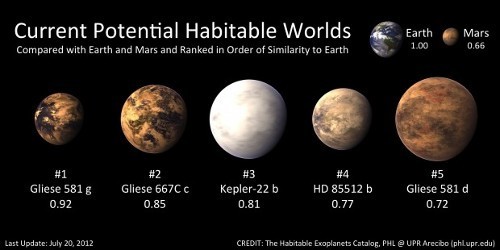
Image: Artist’s conception of five potentially habitable exoplanets, with Earth and Mars to scale. Credit: The Habitable Exoplanets Catalog, PHL @ UPR Arecibo.
Using stable, circular orbits for its modeling, Vogt’s team sees a fifth planet (V10 below refers to Vogt’s 2010 paper):
Contrary to F11’s conclusions, we find that the full 240-point HARPS data set, when properly modeled with self-consistent stable orbits, by and of itself actually offers confirmative support for a fifth periodic signal in this system near 32-33 days, and is consistent with the possibility of having been detected as GJ 581g at its 36-day yearly alias period by V10. The residuals periodograms both of our interacting and non-interacting fits and of the F11 four-planet circular fit reveal distinct peaks near 32 days and 190 days. Both of these residuals peaks are largely simultaneously accounted for by adding a fifth planet at 32.1 days to the system.
According to Vogt, we wind up with a planet with minimum mass of 2.2 times that of Earth orbiting at 0.13 AU, “solidly in the star’s classical liquid water Habitable Zone.” That, at least, is what the data analysis produces if we assume circular orbits of the four known planets and work out the reasons for the further perturbations that Vogt’s team sees as evidence for a fifth planet. Vogt believes a 5-planet model with all circular orbits trumps a 4-planet model with eccentric planetary orbits, but adds that it may take time and further data to give a definitive answer.
What to make of all this? Gl 581 is offering us an instructive example of how tricky exoplanet analysis can be. Here we’re looking at radial velocity data showing Doppler shifts in the light of the star that result from the gravitational pull of multiple planets orbiting it. You can see how complicated a problem this is, and how multiple solutions can suggest themselves. I find myself pulling for Vogt’s team because I want a planet in the habitable zone to exist somewhere near our Sun (Gl 581 is about 20 light years from us), and the new paper is compelling. But we haven’t heard the last of this exoplanet flap, and how it will end is anyone’s guess.
The paper is Vogt et al., “GJ 581 update: Additional Evidence for a Super-Earth in the Habitable Zone,” accepted for publication in Astronomische Nachrichten (abstract). The Forveille paper is “The HARPS search for southern extra-solar planets XXXII. Only 4 planets in the Gl~581 system,” submitted to Astronomy & Astrophysics (abstract).






August 1, 2012
Habitable Worlds around White Dwarf Stars?
Not all that long ago we assumed habitable planets needed a star like our Sun to thrive, but that view has continued to evolve. M-class red dwarfs may account for as many as 80 percent of the stars in our galaxy, making habitable worlds potentially more numerous around them than anywhere. And let’s extend our notion of habitability to what Luca Fossati (The Open University, UK) and colleagues call a Continuous Habitable Zone (CHZ). Now things really get interesting, for a red dwarf evolves slowly, so planets could have a CHZ with surface water for billions of years.

But what about white dwarfs? Stellar evolution seems to rule out habitable worlds around them because we normally think of stars entering their red giant phase and destroying their inner planets enroute to becoming a white dwarf. But can a new planetary system emerge from the wreckage? We’ve already found planets orbiting close to the exposed core of a red giant (KOI 55.01 and KOI 55.02), showing that the end of main sequence evolution isn’t necessarily the end of planetary survival. We’ve also found evidence in the metallic lines in the spectra of white dwarfs for rocky bodies close to such stars, a kind of ‘pollution’ thought to be caused by the accretion of small, rocky worlds or perhaps planetesimals (see Planetary Annihilation Around White Dwarfs for more).
Image: Almost all small and medium-size stars will end up as white dwarfs, after all the hydrogen they contain is fused into helium. Near the end of its nuclear burning stage, such a star goes through a red giant phase and then expels most of its outer material (creating a planetary nebula) until only the hot (T > 100,000 K) core remains, which then settles down to become a young white dwarf which shines from residual heat. Credit: Jonathan Saurine/Science Vault.
The conditions on planets orbiting close to a cool white dwarf might be relatively benign. What Fossati and team show is that the cooling process in these stars slows down as their effective temperature approaches 6000 K, producing a habitable zone that can endure up to eight billion years. And it turns out that white dwarfs offer advantages M-dwarfs do not, providing a stable luminosity source without the flare activity we associate with younger M-class stars. As you would expect, a cool white dwarf has a habitable zone close to the star, ten times closer than for M-dwarfs. One recent study has used this to argue that a Mars-sized planet in the white dwarf CHZ would be detectable with today’s ground-based observatories even for faint stars.
But there are other options including polarized light that may be used to detect a planet with an atmosphere around a white dwarf. Normally, starlight is unpolarized, but when light reflects off a planetary atmosphere, the interactions between the light waves and the molecules in the atmosphere cause the light to become polarized. The paper notes that the polarization due to a terrestrial planet in the CHZ of a cool white dwarf would be larger than the polarization signal of a comparable planet in the habitable zone of any other type of star except brown dwarfs. Analyzing polarization is thus a viable way to detect close-in rocky planets around white dwarfs.
Would the ultraviolet radiation put out by a white dwarf disrupt the formation of DNA molecules? Fossati and company created a computer model to study the DNA dose expected for an Earth-like planet in the white dwarf habitable zone using an Earth atmosphere model. The result:
The DNA-weighted UV dose encountered at the surface of an Earth-like planet in the white dwarf CHZ becomes comparable to that of an exoplanet in the habitable zone of a main sequence star at approximately 5000 K. Interestingly, present-day solar conditions produce an average dose on Earth a factor of only 1.65 less than that for a white dwarf with solar Teff [effective temperature]. Varying terrestrial atmospheric conditions at times produce DNA-weighted doses on Earth as high as that on a CWD planet… [T]he DNA-weighted dose for a hypothetical Earth-like planet around a CWD is remarkably benign from an astrobiological perspective, for an extremely long period of time.
So white dwarfs, the remnants of those stars not massive enough to become a neutron star, may provide us with interesting venues for life. We can even imagine a typical star going through its pre-red giant phase with a planetary system nurturing life and then, after the red giant phase is complete, beginning a post Main Sequence astrobiological phase with a planetary system in a new configuration. The notion is plausible on the strength of this paper, though the researchers point out that 10 percent of all white dwarfs host magnetic fields that could be problematic for life. This paper assumes the hosting white dwarf is a non- or only weakly magnetic star.
The paper is Fossati et al., “The habitability and detection of Earth-like planets orbiting cool white dwarfs,” accepted for publication in Astrophysical Journal Letters (abstract). Thanks to Adam Crowl for the pointer. For more on planets around red giants, see Planets Survive Red Giant Expansion.






July 31, 2012
Communication with Extraterrestrial Intelligence
By Larry Klaes
One result of the biennial Astrobiology Science Conference (AbSciCon) held the last week of April in 2010 was to gather SETI specialists from around the world to look at everything from search strategies and signal processing to the best ways of creating an interstellar message. Tau Zero’s Larry Klaes has been reading the collected papers from the meeting’s SETI sessions, which have inspired him to ponder SETI’s place in the scheme of things and how our reaction to the search tells us something about who we are and who we are becoming. Readers with a long memory may recall that the first major conference on interstellar communications, held in Soviet Armenia in 1971, produced a volume of proceedings titled Communication with Extraterrestrial Intelligence, a title editor Douglas Vakoch deliberately echoes in the current work, partly as a nod to the field’s past and partly as a measure of how far it has come.
I love anthologies. There is nothing like having a collection of information or stories on a particular subject in one easy-to-find spot, particularly in book form.
Among the more prized books in my personal library are the ones which contain the presentation papers and posters of scientific gatherings about the Search for Extraterrestrial Intelligence (SETI) and astrobiology. It is always interesting to see not only how the technology designed for discovering and understanding life beyond our planet Earth has developed and changed over the years through these special publications, but also how the prevailing attitudes about alien life and how humanity should deal with it has evolved.
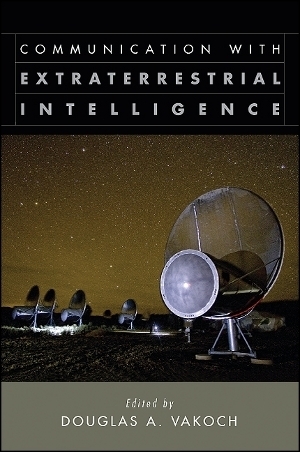
One of the latest such collections to follow in this tradition is titled Communication with Extraterrestrial Intelligence (SUNY Press, New York, 2011), edited by Douglas A. Vakoch, Director of Interstellar Message Composition at the SETI Institute and Associate Professor of Clinical Psychology at the California Institute of Integral Studies.
To quote from the summary on the publisher’s Web page for this book:
“In April 2010, fifty years to the month after the first experiment in the Search for Extraterrestrial Intelligence (SETI), scholars from a range of disciplines—including astronomy, mathematics, anthropology, history, and cognitive science—gathered at NASA’s biennial Astrobiology Science Conference (AbSciCon) for a series of sessions on the search for intelligent life. This book highlights the most recent developments in SETI discussed at that conference, emphasizing the ways that SETI has grown since its inception.
“The volume covers three broad themes: First, leading researchers examine the latest developments in observational SETI programs, as well as innovative proposals for new search strategies and novel approaches to signal processing. Second, both proponents and opponents of “Active SETI” debate whether humankind should be transmitting intentional signals to other possible civilizations, rather than only listening. Third, constructive proposals for interstellar messages are juxtaposed with critiques that ask whether any meaningful exchange is possible with an independently evolved civilization, given the constraints of contact at interstellar distances, where a round-trip exchange could take centuries or millennia.
“As we reflect on a half-century of SETI research, we are reminded of the expansion of search programs made possible by technological and conceptual advances. In this spirit of ongoing exploration, the contributors to this book advocate a diverse range of approaches to make SETI increasingly more powerful and effective, as we embark on the next half-century of searching for intelligence beyond Earth.”
The Dangers of Analogy
As pleased as I was to see one of these professional conference collections finally get past focusing primarily on the technical aspects of mainstream SETI and do more than just a token nod to other search concepts and the philosophical implications of contacting an alien civilization, I think there are two major points still being largely missed here. They are ones that must be addressed if humanity ever wants to actually find and talk with another set of intelligent minds.
My first issue is that we keep using the same terrestrial analogies and examples when attempting to figure out how an alien being might function and respond to the Universe and to us. Now one’s natural first reaction to this statement would be “Of *course* we use the same examples over and over! If we could ever find an actual alien life form, we would not need to keep dipping into the same wells!”
I know this appears to be a Catch-22 situation, but a large part of it stems from the fact that five decades after Frank Drake scanned two nearby star systems for a couple of months with a radio telescope, we may have increased the quantity, quality, and even the variety of methods for conducting SETI to a degree, but we have not made nearly the amount of progress in this field that we should have and could have by now.

In many respects, SETI is still stuck in the paradigm famously set in 1959, when Guiseppe Coconni and Philip Morrison wrote that landmark paper published in Nature which stated the most efficient way for a technological intelligence to communicate between the stars is by radio waves – after considering and rejecting the possibility of using gamma rays as an interstellar transmission method.
Image: Philip Morrison (1915-2005), whose paper on radio methods for SETI established early parameters for the field. Credit: MIT.
Radio telescopes were the hot, new instruments for exploring the celestial heavens in the 1950s, being perhaps one of the biggest innovations since the development of the optical telescope for astronomy four centuries earlier. Combining this field with the equally new and even daring scientific acceptance of advanced extraterrestrial intelligences as a plausible reality was nothing less than cutting edge for its day.
If one asked a typical scientist in 1959 how they envisioned the kind of alien beings they might be able to detect using radio technology, the majority of them would give the answer one would find going back to the earliest days of science fiction: As dwellers of an Earthlike planet circling a Sol-type star. The assumed beings themselves may not be exactly human-looking or behaving, but most would probably not deviate too far from the one head and four major appendages attached to a torso model. Of course there were a few notable exceptions in the fictional and factual literature of that era, but the standard ETI did not stray too far from what was found in the Sol system.
Now some other ideas for conducting SETI did arise about the same time, most notably the idea that powerful optical or infrared lasers might be used to signal with light from one world to another. While lasers did have the advantage over radio waves of being able to carry a lot of information and be much easier to detect than sifting through literally millions of radio frequencies, Radio SETI had already developed a strong following by the early 1960s and Optical SETI would not see any serious participation by observatories until the late 1990s.
Radio Silence
It has now been over fifty years since Project Ozma and there has yet to be one verified detection (meaning repeatable) of an artificial signal from an alien civilization. While I know that half a century is a proverbial drop in the bucket of cosmic time when it comes to the age of the Milky Way (ten billion years) and the whole Universe (13.7 billion years), one thing that must be recognized by now is that there is not a lot of strong or at least obvious interstellar chatter on the radio portion of the electromagnetic spectrum, at least in our part of the galaxy right now. This reduces the theory by some of the SETI pioneers that sophisticated alien societies had a vast and probably ancient interstellar communications system which we primitive humans were missing out on.
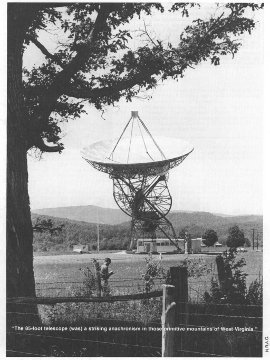
Now of course one can say that maybe there is the equivalent of the Galactic Internet and we have just not tuned into the right frequencies, or that its extraterrestrial participants purposely do not want humans and species like us among its utilizers. However, even these possibilities add up to the fact that we should be seriously conducting other types of SETI in addition to radio.
Yes, we have been doing some Optical SETI for just over a decade now and there have been a few other efforts outside the mainstream of the field, but if one looks closely at the history of SETI, they will see that the majority of projects were focused on the radio realm and until recent years were largely temporary efforts in both scope and time. There have been a few long-term SETI projects such as the one conducted at OSU from 1973 to 1998, SETI@home, and the recent Allen Telescope Array (ATA). However, these too had and have their own set of limitations; in the case of the ATA, it is under the continued threat of losing its funding. Whole realms of space and time have been neglected by our limited and limiting efforts to find other minds in the Universe due to being mired in specific paradigms as much as limits to money, resources, desire, and imagination.
Image: The radio telescope at Green Bank, WV used by Frank Drake for Project Ozma. Credit: Cosmic Search/Frank Drake.
The other hampering point for SETI is our collectively fundamental lack of appreciating the very strong possibility, even probability, that beings which evolve on other worlds – and by worlds I do not mean just Earthlike planets – are NOT going to be like humans or even other forms of terrestrial organisms.
Imagining Alien Life
Part of the blame for this is our relative lack of extensive knowledge about the cosmic realm in which we live. Take, for example, the broad layout of the known Universe: Scientists did not generally accept the fact that our Milky Way galaxy was not the only stellar island in all of reality but just one of billions until the 1920s! This was a cognitive step comparable to the realization just a few centuries earlier that Earth was but one planet circling the Sun, which in turn was just one of many billions of stars in a Universe far vaster and more complex than ever dreamed of before by the human race.
Only a matter of decades ago did we start to reveal the true natures of the worlds in our celestial backyard known as the Sol system, thanks to the development of robotic space probes capable of traveling the many millions of miles across the interplanetary void to these alien places. As often happens when one journeys to new lands, many new facts appeared and old paradigms were washed away, especially when it came to learning what worlds might make good abodes for life.
Our knowledge of worlds beyond our Sol system came even later, with astronomers proving their existence only in the last decade of the previous century. Before these discoveries, most scientists and even science fiction writers assumed that other solar systems would generally resemble our own, with small, rocky planets near their star and the giant gas worlds much farther out.
The reality of the first exoplanets found was something virtually unexpected: Massive worlds larger than Jupiter were orbiting their suns not in wide orbits taking decades to complete, but so close that these planets could circle their star in a matter of days! Granted, these early discoveries were among the easiest to detect due to the indirect methods performed to find them.
Nevertheless, as we have come to confirm thousands of these alien places so far, the vast majority are still super Jovians that practically hug the photospheres of their parent suns, with few resembling our solar system. We have even confirmed that a number of exoworlds are residents of multiple star systems, something thought improbable not very long ago due to presumed gravitational instabilities. This should provide an intellectual caution and guide as to what we may actually find out there when it comes to alien life, as opposed to what we have been thinking for centuries concerning what lives in our galaxy and beyond.
Extraterrestrials and the Media
The other culprit in our assumptions about alien life, intelligent and otherwise, is how our entertainment and media outlets have portrayed beings from other worlds, especially since the late Nineteenth Century.
Granted, due to a severe lack of actual evidence, humans have always projected their assumptions, hopes, and fears on alien life forms going back to ancient Greece, when the concept was first seriously formulated – as opposed to making all extraterrestrial beings supernatural deities and spirits from some mystical planes of existence. However, in those days there was almost no expectation of humanity ever meeting or even conversing with their cosmic brethren, at least not until people began to seriously consider such possibilities as our science and technology advanced.
Ask a typical person, even educated professionals, what they think beings from beyond Earth might be like, and one will more often than not be given a picture that mirrors what is generally predicted in our science fiction literature and films. What one finds are beings that resemble monstrosities, either of the mindless destructive and consuming variety, or ones that desire the conquest and enslavement of humanity and every other species in the galaxy.
At the other extreme, aliens have also been envisioned as our wise and angelic saviors, saving us from our pitiful, primitive selves so that we may one day join a Federation or Galactic Brother/Sisterhood of other civilizations throughout the galaxy.

Image: From 1951′s The Day the Earth Stood Still, Michael Rennie as a humanoid alien with a message for Earthlings. Credit: Twentieth Century Fox.
All these attempts to wrestle with habitats and visualize aliens might be called part of the intellectual growing pains of a species that is literally trying to find its place and way in the vast Universe. While we have many questions left to answer, human civilization is now at a technological and knowledge stage where we can start to move beyond a number of our initial ideas and interpretations that ushered in the early days of SETI. Otherwise the field will continue to return only negative results, which may lead to conclusions that will not only derail our efforts to find ETI but even bring harm to our species and society down the road.
Searching on a Shoestring Budget
First is the need to change the fundamental elements of SETI as established over fifty years ago. While there is no logical reason to abandon the search for alien intelligences in the radio spectrum – radio still remains an easy and inexpensive way to communicate across the interstellar distances – one thing we have learned after five decades of scanning those frequencies (even longer if you include the earlier efforts to listen for any messages from Mars) is that this part of the Milky Way at the least is not currently brimming with transmissions between civilizations as the early SETI pioneers conjectured and hoped.
There is of course always the possibility that a radio transmission, either deliberate or as part of the electromagnetic leakage of a technological society, may be heading our way at any time, or perhaps already has arrived: The Wow! signal detected by the Ohio State University (OSU) SETI program in August of 1977 certainly had many of the characteristics of an artificial interstellar signal. Unfortunately, the signal was not found until hours later when a team member discovered it on a recording printout, and the signal has never repeated since, a major criterion for science.
Now there has been some expansion to the SETI paradigm in the last few decades. Most SETI programs in the United States no longer rely on government funding, which proved itself unreliable when the funding for NASA’s SETI program was abruptly cut in 1993 after one year of operation due largely to Congressional ignorance. While this has allowed a degree of freedom and latitude when it comes to expanding SETI’s parameters and techniques, these private efforts have also been subject to the whims of the economy. Ironically, the ATA depicted on the cover of Communication with Extraterrestrial Intelligence has been hit by funding problems and is so far remaining alive with public donations and the support of the United States Air Force – which is using the vast field of radio telescopes to track artificial debris in Earth orbit.
Optical SETI finally entered the mainstream in the late 1990s after decades of neglect and resistance by radio SETI advocates. It too, however, has yet to find a laser or infrared transmission from the stars.
There have been other searches for alien technologies such as the Fermi search for Dyson Shells in 2005. In reality, though, most SETI projects of all stripes have been largely sporadic, even token in the number of cases. For most of its history, SETI has been placed on the sidelines, begging and scraping for time on telescopes and suffering from misunderstandings, ridicule, and being lumped in with pseudoscience.
This attitude can be blamed primarily on the following:
A sincere yet misguided old school view that solar systems are rare (and thus life) due to the pre-nebular hypothesis of how planetary systems form, which involves one star passing by another and pulling material from its photosphere into nearby space to form a debris ring around that sun, which eventually becomes the various worlds of a solar system.
Antiquated views going back to Aristotle and Plato and reinforced by various religious, political, and psychological factors in later centuries that hold we and Earth are the spiritual and literal focus of existence and as a result no other beings exist in the Universe, which until the most recent era was considered to be relatively small compared to what we know now.
The popular (read general public) take on aliens, which between their portrayal in most science fiction has created a virtual belief system in beings who can be either our destroyers or saviors. Aliens in our culture are also often used as substitutes for various human groups in science fiction and as comic relief. Seldom do these images add much to the scientific database of ideas on how and what our cosmic neighbors may truly be – though they do have something to say about human attitudes and thoughts on this subject. The results are a misinformed public and politic and a scientific community that is more embarrassed and dismissive than encouraged to pursue the search for any real ETI.
This comes to the second point: Making the human race truly aware and appreciative of our place in the real Universe, beyond the confines of our pale blue dot, as Carl Sagan so famously referred to the planet Earth.
Public Perception of the Cosmos
I know that on an intellectual level we have come a long way from the time of Nicholas Copernicus when he cautiously introduced in 1543 the idea that Earth circled the Sun and not everything orbiting our planet or otherwise focused upon it and us. Nevertheless, there are plenty of people living now who, despite access to vast amounts of information as never before, either do not know/appreciate that we live on a rotating planet orbiting a star or just do not care due to their education level, the quality or lack thereof of their everyday lives, and the fact that the vast majority of us have never been into space and in many cases cannot even see the stars and most other celestial bodies from the surface of Earth due to light pollution.
Which leads to my third and key point: Are we as a species and a society truly capable of finding, understanding, interacting, and dealing with an intelligence which evolved on an alien world? Or is this the ultimate reason as to why our current SETI efforts have so far found no definite signs of anyone else in the Universe? If the answers to these questions show that we are still too immature for such an endeavor, should we just give up and hope that some day natural evolution will make us a bit more cosmically oriented? Or should we strive to build something that will complete our goals for SETI, METI, and CETI?
As pointed out previously, our combination of cultural ignorance, apathy, paranoia, and misdirection due to the depictions of aliens in most science fiction has left us in numerous fundamental ways little advanced from the perceptions and theories about ETI going back centuries.
For a prominent example of what I am referring to, read up on the history of the astronomical study of Mars in the late Nineteenth through the early Twentieth Century, from the time when Italian astronomer Giovanni Schiaparelli first noted the (in)famous canals crisscrossing the face of the Red Planet in 1877 to the era when the first robotic space probes finally began to reveal the true nature of Mars in the first decades of the Space Age.
Even though the stories refer to a world we now know is not inhabited by an intelligent alien race, advanced, dying, or otherwise, if one removed the location of the planet in question from the literature of the day on the subject – especially those works by Percival Lowell – the topics of conversation would be remarkably similar to the ideas and debates going on to this day regarding ETI, even with over a century of hindsight in our favor.
Accepting the idea that our seeming lack of success with SETI and METI is due to limitations with our experience and technology with these fields, could it be that we are ultimately just not capable of dealing with a species not from this planet due to the state of our biological evolution? Humanity certainly has enough issues and misunderstandings with members of its own species, to say nothing of other high minds on Earth such as the cetaceans. So how can we expect to grasp the truly alien?
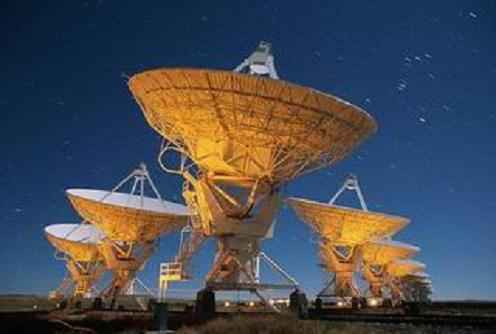
Moving Past Biological Evolution
Will the beings that eventually come form this planet which can find, understand, and interact with ETI not be humanity but minds that we created? Hugo de Garis calls them Artilects, which is short for Artificial Intellect. We have the potential to build beings which would have intellectual capacities that dwarf ours with ease, ones that could easily handle intelligences from other worlds. It has been speculated that if there are other advanced minds out there, they will be the alien versions of Artilects, the natural and ultimate step in the process of biological evolution across the Universe. Of course this could all be short-sighted too, but it does offer one explanation as to the seeming silence out there: Current humanity just is not on the same playing field when it comes to cosmic correspondence compared to a mind unfettered by relatively slow biological evolution.
So what do we do? Do we just become overwhelmed by the Cosmos and give up trying to understand and explore it? Besides the fact that such an action will not happen at least collectively so long as we are alive and have a civilization (even during the European Dark Ages there were still groups of people who strove to record and comprehend the world around them, limited as their capabilities were), the short answer is no – though a few caveats, improved resources, and better attempts to appreciate the Universe as it really is and not as we wish it to be are in order.
Limited as our SETI and METI efforts may be, they have been of benefit to our species. Look at the number of sections in the CETI book devoted to our attempts at communicating and understanding an alien mind. Such exercises not only help us for the day when we do detect an ETI at least at some levels, but they are very good at helping us deal with each other.
Take note of the Pioneer Plaques and Voyager Interstellar Records now wending their ways into the wider Milky Way galaxy. Even if an interstellar species finds them one day in the far future, even if the ETI cannot understand what is on these golden objects or miss their purpose and presence entirely, the plaques and records have done much to make us see ourselves as members of one species on a planet in space. I have read that the music on the Voyager Interstellar Records was one of the first collections of world music ever put together.
Perhaps most importantly, these pioneering attempts at METI justify their existence by the very fact that a collection of humans had the desire and ability to be aware to the possibility of other beings in the Universe and make an effort based on the higher scientific and technological ideas and tools of the day to reach out to them in a way designed to benefit both parties.
So let us keep the radio on and tuning through the static for whoever may be out there. The beauty of radio is that you can work on other things while listening to it.






July 30, 2012
On Cosmic Isolation
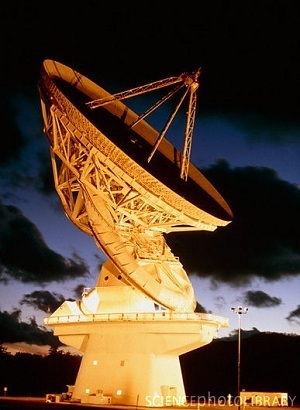
Michael Chorost is a science writer whose research interests grow directly out of his personal experience. You may have already read about his struggle with hearing loss — a problem he has dealt with since childhood — in his book Rebuilt: How Becoming Part Computer Made Me More Human (Houghton Mifflin, 2005). It’s natural to find Chorost writing often on things like cochlear implants and neurotechnology, but intriguing to find that he is also a SETI advocate, and one who believes his hearing issues have a bearing on a field he has studied passionately all his life. In fact, the book he plans next, which follows on 2011’s World Wide Mind (Free Press) will be a SETI title.
So what’s the connection between deafness and hunting for signs of an extraterrestrial civilization? Chorost sees it as a matter of isolation and communication, as he notes in a recent entry on the Psychology Today site. Is the entire human race subject to deafness? It is in the sense that we have no idea whether or not we live in isolation or in a galaxy populated with other intelligences. Our ignorance of our place in the universe becomes its own kind of perception problem, a deafness SETI has been trying in vain to remedy for the last fifty years.
Image: Dish antenna of the 43-metre (140-feet) radio telescope at the Green Bank observatory in West Virginia. Credit: Seth Shostak/Science Photo Library.
It’s an interesting idea, and one the author develops by looking at a recent article by Atul Gawande in The New Yorker. Gawande focused on the effects of solitary confinement on people, relating the story of one prisoner held in such conditions in a maximum security prison who began to lose his mind. The argument is that without encounters with other people, we find our psychic integrity threatened. In the case under study, prolonged isolation led to compulsive behavior, panic attacks, hallucinations and increasing paranoia. Looking at how people relate to those around them, Chorost wonders about a planet-wide pattern of isolation:
I think the analogy is pregnant and poignant, but unproven. Still and all: crazy prisoners, crazy planets. Contact and communication with other planets might have a calming effect on a civilization, giving it perspective and self-knowledge. After all, it’s mainly through interaction with other people that we get feedback on our behavior. We know ourselves by how people reflect us back to ourselves. The Other is a kind of mirror. Right now, humanity has no way to see itself in perspective. We just don’t know what’s abberational in intelligent species, and what’s normal.
So we could be looking at one more possibility for explaining the Fermi paradox. Extraterrestrials are not here because they think we’re lunatics. It’s not a likely scenario, and Chorost doubts it applies, but there is something to be said for the idea of planets facing existential loneliness:
I think that deafness and planetary isolation have something in common. A deaf person knows how easy it is to become profoundly cut off. (If civilization collapsed and the electricity went out for good, my rechargeable cochlear implant batteries would last me about a week.) I think of our planet swimming in the starry blackness, studded with radio telescopes peering anxiously into the void—and hearing nothing. To me, that feels a lot like being deaf.
When I was growing up, my uncle from Florida used to drive up once a year for an extended visit. He was already going deaf at the time and thought it was from the effect of aircraft engines (he had serviced radio equipment for Eastern Airlines his entire career). In any case, over the years his deafness became profound. Like Chorost, he was also fascinated with SETI and the idea of finding other intelligences. He had huge problems communicating with people in conversation, but he built a world out of books and kept a massive library. I often wondered, when deafness closed off his interests in music and shortwave radio, whether he felt the same sense of bafflement I feel when walking on a starry night, wondering whether there is anyone out there sharing this universe, pointing instruments into the sky and asking why no one speaks?






July 27, 2012
Defending the Interstellar Vision
An interstellar movement has been brewing for the past sixty or so years among physicists and engineers who have taken a serious look at what it would take to get to the stars. Their work is not based on wishes but on physics, and while they are aware of the intractable distances to reach even the nearest star (4.2 years at the speed of light itself), they have continued to study how to send spacecraft on such epic journeys. Organizations have emerged — DARPA’s 100 Year Starship, Icarus Interstellar, the Tau Zero Foundation — whose members call to mind physicist Robert Forward’s injunction: “Travel to the stars is difficult but not impossible.”
Centauri Dreams readers know all this, but at least on the basis of Adam Frank’s op-ed Alone in the Void, many readers of The New York Times do not. A professor of physics and astronomy himself (University of Rochester), Frank is well versed in the problems of distance and time and understands how difficult it will be to send humans to the stars any time soon. But while acknowledging the ‘exciting theoretical research’ on unmanned vehicles currently underway (Project Icarus is an ongoing design study for such an unmanned probe), he leaves the implication that rapid interstellar travel is nothing more than a Hollywood fantasy.
Interstellar Concepts Emerge
Yet ever since the first serious studies of interstellar propulsion began in the 1950’s, numerous concepts for crossing the starry gulf have been examined that violate no laws of physics and could well be achieved by a civilization with the technology our grandchildren — or their children — may have at their disposal. We can’t get a huge space sail to ten percent of lightspeed by beaming a powerful laser at it, but our descendants may have the energy resources to do just that. We’ve been looking in these pages at ramjet concepts that in some cases use interstellar hydrogen and in others tap energy from X-ray lasers, while others examine the potential of nuclear fusion. A century from now we may have learned how to use antimatter in rockets.

Image: The Andromeda galaxy reminds us how vast cities of stars like the Milky Way really are. Will humans ever be able to leave our Solar System and reach even the closest stars? Credit: Bill Saxton, AUI, NRAO, NSF.
History reminds us that while progress is not inevitable, it can move quickly once unleashed, as the digital revolution of the last few decades attests. Our advances in computers may be complemented by a nanotechnology that will allow us to lower payload mass and make the propulsion problem a little less intractable. These concepts aren’t yet focused on human interstellar flight but there is no reason why taking the first steps in examining them couldn’t eventually lead to that outcome. But what Frank is saying is that going to the stars is such a long-term prospect that we might as well consign the idea to the realm of magic.
For the concepts I’ve cited simply don’t appear in Frank’s essay, nor does he mention the work of NASA’s Breakthrough Propulsion Physics project, or the recently published Frontiers of Propulsion Science, which collects essays from leading theorists on the latest research and how it might be applied. Instead, he focuses on Hollywood:
From “Star Trek” to “Star Wars,” from warp drive to hyperdrive — the idea of rapid interstellar space travel is such a deep meme for cultural visions of space and our future that Hollywood films don’t even have to waste time introducing them to the audience. You pull a lever and zap — you are in a new star system. How many people would be surprised to know that warp drive isn’t even a coherent concept, let alone a near-future technology?
Starflight and the Human Lifetime
Does warp-drive — if it ever becomes possible — have to be a near-future technology for us to study it? Here I question Frank’s assumptions, because the curse of our times is our focus on short-term results, and our unwillingness to look beyond our own lifetimes. The warp drive under question would not violate Einstein’s Special Relativity because rather than moving an object through spacetime, it would manipulate spacetime itself, an operation requiring vast amounts of energy but one on which there is no such speed limit. No one knows whether these investigations — or those into ‘wormholes’ that could be traversed to connect remote parts of the universe — will ever bear fruit. It is safe to say, however, that if we dismiss any study of these concepts we have guaranteed a negative result, and why do so?
Frank goes on to describe what he calls ‘an inconvenient truth’:
While our children’s children’s great-grandchildren will live with ever more powerful technology, they will also live ever more intimately with ever more billions of others in this, our corner of the cosmos. Looking back and forward, my bets are now on that same human genius, ambition and hope to rise to the occasion. We will have no other choice. There will be nowhere else to go for a very long time.
Who could doubt that this vision, of humans living on an ever more crowded Earth, is likely to come to pass whether or not we develop human interstellar flight? And yes, learning how to live with each other is not a matter of choice as our technology and our weaponry become ever more advanced. But the interstellar movement notes several other key points, and I bet on its genius, ambition and hope. Even as our species nurtures the home world, we live in a dangerous environment whose history has been punctuated by mass extinctions, some of them caused by impacts from space debris.
Getting representatives of humanity off this planet is an insurance policy that guarantees our survival. Let’s forget fast travel for the moment and take an evolutionary view of what could occur. Human expansion into the Solar System involves developing new propulsion technologies to help us change the trajectory of potentially dangerous impactors like asteroids. In doing this, we master techniques for living in space that result in large habitats off-planet. None of this violates any laws of physics and invokes no magic, but it potentially leads to self-sustaining colonies, born and bred in space, spreading out on millennia-long interstellar journeys.
Of Vision and Commitment
Focused attention can be disruptive, as physicists and engineers go to work on problems that seem intractable, and we cannot know what might rapidly accelerate the time-frame for interstellar flight. But a commitment of a small part of our resources to studying how we might one day move out into the stars is a long-term investment whose outcome may surprise us. History shows that humans are a visionary and exploring species. We will move into the cosmos if we can because it is in our nature, and it is the nature of researchers in today’s interstellar movement to take the small steps of foundation-building that may lead to a grand structure in the future.
Frank is certainly correct that the time-scale is long and the result unsure, and he’s also right that Hollywood versions of star travel have simplified it to the point of absurdity. No one can guarantee that humans will ever travel to the stars, but it is a dead certainty that giving up in despair will leave the outcome in no doubt whatsoever. Meanwhile, interstellar theorists learn patience. They have to, for they understand that the first interstellar probes, even the unmanned ones, surely won’t fly in their lifetime. Why should this be so hard to explain to the readers of a great newspaper? Since when did we lose the ability to see beyond our own mortality, building a vision that someone we’ll never know in a century we’ll never see can finally make real?






July 26, 2012
Al Jackson: A Laser Ramjet Reminiscence
by A. A. Jackson
It’s always good when you can go to the source, which I am delighted to do with this reminiscence by Al Jackson, whose laser-powered ramjet (and laser-powered interstellar rocket) ideas we’ve been looking at for the past few days. Al recalls discovering the work of Eugen Sänger back around 1960 and beginning the study of interstellar propulsion ideas, a passion he continues to this day. His 1975 doctorate from the University of Texas at Austin followed his work for NASA during the heyday of Apollo as astronaut trainer on the Lunar Module Simulator. Here he thinks back to the genesis of his interest in astronautics and reflects on the factors that led to his combining the Bussard ramjet concept with the developing idea of beamed energy.
I don’t think I had ever planned to write a technical paper about interstellar flight. However, as an SF reader I had been entranced by the idea since the early 1950′s. I was already a space cadet! When I got to university in 1959 and started with math and physics I became obsessed with astrodynamics even though I have never taken a course in it. I have a huge collection of celestial mechanics and astrodynamics books, and made my living off that branch of astronautics for nearly 45 years.

My curiosity about interstellar flight (IF) led to haunting libraries for technical works. I had read Les Shepherd’s work on IF and was entranced and it taught me one needed to learn Special Relativity. So I started collecting IF papers. The first thing I learned was the mass-ratio problem, which is why I was thunderstruck by Bussard’s ramjet paper. Lucky for me to work in a library in 1960 at a time when they were throwing out donated journals … Astronautica Acta being one of them! I still have my original hard copy of the issue with Bussard’s paper in it.
It was not hard to collect applied physics IF papers, just not many for a long time. I even joined the British Interplanetary Society to make sure I got the red cover issues [devoted to interstellar flight]. When I was working in the Apollo program two papers really caught my eye, both in Nature, one by G. Marx and the other by J.L. Redding, 1966 and 1967, about a laser pushed IF spacecraft (I don’t think Forward touched on this idea for quite some while later). Papers just accumulated.
I got more and more interested in General Relativity, the 70′s being the great era of applied GR. So I spent 5 years in Austin, in the Relativity Center at UT, more concerned with black hole physics and gravitational radiation. As I have mentioned before, I met Dan Whitmire there. We talked about a lot of things including my interest in IF, which caught his imagination. Soon we were talking and talking about it and I gave him copies of many of my papers. He too was struck by Bussard’s idea , which lead to the catalytic ramjet [See Tuning Up the Interstellar Ramjet].
I puzzled and puzzled over how to get rid of the fusion reactor and the idea struck me in about 1974 to combine a laser sail with a ramjet, but I was writing my dissertation at the time (on gravitational radiation) and didn’t have time for it. After getting my PhD in 1975 I went back into the space program (getting an academic job in physics by the early 70′s proved to be too long a process, which is why I took this course), and that is why the laser-powered ramjet paper has a disclaimer saying my work on it was not connected with my duties at the McDonnell Douglas Corporation.
By this point I knew the Special Relativity, had the concept, and so hobby-worked all the calculations on the paper, after which I sent it to Dan. He suggested a paper. I was very busy but sent him an outline from which he wrote the paper with some improvements and organization and some new ideas (note the ‘runway’ idea, did we originate that?)
[Editor’s note: Let me quote from the Jackson/Whitmire paper on the fusion runway concept, which I haven’t described in the two earlier posts:
Another possibility would be to artificially make a fusion ramjet runway. Micron-size frozen deuterium pellets could be accelerated electrostatically or electromagnetically beginning several years prior to take-off at which time a fusion ramjet with a relatively modest scoop cross section (perhaps a physical structure) would begin acceleration.
I always associate the fusion runway concept with Jordin Kare and his ‘Bussard Buzz Bomb,’ but I’m pretty sure Al’s work pre-dates Kare -- PG].
My real focus was on the efficiency problem… Looking back on the paper now I can see we really should have emphasized the technicalities. We should have emphasized more that several different non-fusion systems could be used as ‘engines’ to accelerate mass. The laser beam set-up could have been much the same as what Forward studied a few years later. I think the generic scoop physics problems are there too, though I have a hunch that there are solutions to the Fishback-Heppenheimer-Zubrin ramscoop problems.
And I still regret the blasted primitive plotter I had at work in 1976 when the paper was being written….
Thanks Paul for bringing up this concept again. Over the many years now Dan and I have been somewhat disappointed at its submergence. Thankfully Eugene Mallove and Gregory Matloff did give us a nice treatment in The Starflight Handbook.
Re the posts here on Centauri Dreams, I agree with the comments by Eniac about technical problems of the collector and actually the whole technology of this concept. Yet this is true of all large scale relativistic interstellar vehicles as Esnault-Pelterie, Shepherd and Sänger noted so long ago. The importance is in showing that the physics allows an opening for the engineering physics. There is no exotic physics here only, so to speak, exotic technology.
For a long time no real details were known about the Interstellar Medium. It was not until the 90’s with astrophysical measurements and direct data such as from the Ulysses spacecraft that it became evident that the local ISM is really pretty slim and the distribution of hydrogen in the rest of the Galaxy varies greatly with no definitive global estimate. Any ramjet technology will face this problem.
(PS: That picture of me in the Lunar Module Simulator was only the third time I ever wore it. We had a simulation of the environmental control system in the simulator and the ECS guy was looking for short guys. Most of the astronauts, during Apollo, were under 6 ft. So that’s astronaut Dick Gordon’s practice suit I am wearing, no one touches the mission suits. I have a picture with helmet on, the system worked fine. Alas the crews when training in Houston hated sim training suited. There was an identical set at the Cape, in those days, and they ran suited there, but almost never in Houston. My only real touch with ECS; my subsystems were Guidance, Navigation and Control).
The two papers Al mentions above are Marx, “Interstellar Vehicle Propelled by Terrestrial Laser Beam,” Nature 211 (1966), pp. 22-23, and Redding (with the same title), “Interstellar Vehicle Propelled by Terrestrial Laser Beam,” Nature 212 (1967), pp. 588-589.






July 25, 2012
Rocketry on a Beam of Light
The year after Al Jackson, working with Daniel Whitmire, published his concept of a laser-powered interstellar ramjet, the duo returned in the pages of JBIS with a spinoff design. The issue was obvious: Central to Robert Bussard’s ramjet design was the idea that the spacecraft would carry no fuel, but collect reaction mass from the interstellar medium. There were a number of reasons why this was problematic, including the drag of the ram scoop and the problem of lighting proton/proton fusion. So Jackson and Whitmire decided to look at a space-based laser powering up a starship that carried its own reaction mass onboard.

It turned out that John Bloomer had looked at supplying a spacecraft through an external laser energy source as far back as 1967, though in his case the craft would use the laser energy it received to run an electrical propulsion system (the Bloomer citation is given at the end of this article). Jackson wanted to think in terms of relativistic interstellar flight, and he and Whitmire proceeded to look at how an interstellar rocket carrying inert reaction mass would accelerate. Their paper, “Laser Powered Interstellar Rocket,” was among other things an attempt to explore the areas where beamed energy could interweave with conventional rocket design.
Image: Al Jackson in the heady days of the Apollo program, when he was astronaut trainer on the Lunar Module Simulator.
We can assume hydrogen as the reaction mass onboard the rocket that will be energized by the laser source in the Solar System. Bloomer’s work in the 1960s is interesting — I’ll want to talk about him in other contexts soon. For now, though, it’s the later work of Jackson and Whitmire that first tunes up the laser-powered ramjet and then extends the notion to the modified design the authors call a laser-powered rocket. Like the laser ramjet, the laser-powered rocket has a significant advantage over laser-beamed lightsails in that it can accelerate into the laser beam as well as away from it, since the beam is being used only as a source of energy and not momentum.
You can see how the laser-powered rocket introduces an initial problem into the beamed propulsion concept. As Greg Matloff and Eugene Mallove noted in their book The Starflight Handbook (Wiley, 1989), the beauty of a beamed lightsail is that leaving the propellant behind works wonders on the mass — the same can be said for the ramjet — whereas adding reaction mass works against this trend. But beaming and rocket technologies have been in play since Arthur Kantrowitz (Avco Everett Research Laboratory) first studied using lasers to boost payloads into Earth orbit in 1972. Matloff and Mallove would go on to analyze the performance of a laser-electric ramjet and speculated on using a sail to boost it to an initial velocity of 0.003 c. Laser beaming ideas now extended far beyond Forward’s lightsails. From The Starflight Handbook:
Consider a laser ramjet with a ramscoop, formed with a ‘modest’ 1000-km radius magnetic field…, and coursing through an interstellar medium with 105 ions per cubic meter. The starship’s collector would receive laser energy and use it to increase the kinetic energy of the ion exhaust. We assume that the laser light would be converted to exhaust kinetic energy with an efficiency of 50%. The laser power might be in the range of 104 to 105 megawatts (of the same order as that proposed for Starwisp); the ion exhaust velocity, 5000 to 10,000 km/sec; and the total starship mass, 7.5 X 103 tons.
And what of the transmitting installation? As you would imagine, it’s big:
The required aperture of the Solar System laser transmitter: 100 km for a 2 ly transmission distance and 1000 km for 20 ly. The laser ramjet may be of service for one-way colonization missions requiring a few centuries of travel time.
Looking at Jackson and Whitmire’s numbers and comparing the laser ramjet to the laser rocket, Matloff and Mallove concluded that the laser rocket would be superior to the ramjet for flights to nearby stars like Alpha Centauri and Barnard’s Star, while more distant destinations would demand the ramjet. It’s hard to predict whether a civilization would support a laser installation beaming out huge quantities of power for half a millennium, but Matloff and Mallove note that it would be possible to keep the laser-powered ramjet under the beam for the full duration of the mission, which would allow, by their calculations, an Alpha Centauri crossing in 350 years.
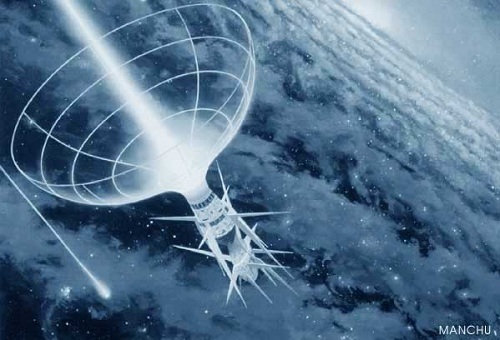
Adam Crowl pointed out to me that Iain Nicholson discussed the laser ramjet in his book The Road to the Stars (William Morrow, 1978), prompting me to dig out the reference (it’s surprising how often this book turns out to be useful, and I suggest finding a copy for your shelves if you don’t already have one). Nicholson runs through the advantages of the laser-powered ramjet, including its ability to fly into the beam when returning (where it becomes far more efficient at energy-gathering) and its ability to use the beam to decelerate at destination using the beamed energy even though the spacecraft is receding from the beam. He adds:
Ignoring the problem of focusing all the energy in the beam onto a starship at a range of several light years (and these problems are formidable), calculations suggest that in principle the system should be more efficient than the laser sail (LPV) which utilizes the momentum of photons. Because the vehicle will be using the energy of the laser beam, high-energy photons will be required, suggesting the need for using X-ray lasers. At relatively low speeds (up to 14% of light speed), it should be more efficient than the ‘conventional’ interstellar ramjet (ISR), but above that speed the ISR becomes more effective.
Jackson and Whitmire anticipated the focusing objection, acknowledging that focusing over multi-light year distances was well beyond forseeable technology and would require, as Nicholson notes, an X-ray laser with a huge effective radiating area. But they suggest that with anticipated technology we might build phase arrays of lasers up to 10 kilometers in diameter with a diffraction limited range of 500 AU for visible light. This would allow what they describe as a ‘small-mass low-relativistic one-way probe,’ our first attempt at an interstellar crossing.
The paper is Jackson and Whitmire, “Laser Powered Interstellar Rocket,” Journal of the British Interplanetary Society, Vol. 31 (1978), pp.335-337. The Bloomer paper is “The Alpha Centauri Probe,” in Proceedings of the 17th International Astronautical Congress (Propulsion and Re-entry), Gordon and Breach. Philadelphia (1967), pp. 225-232.






July 24, 2012
A Laser-Powered Interstellar Ramjet
Many of the interstellar concepts I write about in these pages take on a life of their own. After the initial brainstorming, the idea gets widely enough disseminated that other scientists take it on, looking to modify and improve on the original concept. That’s been true in the case of solar sails and the more recently devised ‘lightsails,’ which use beamed energy from a laser or microwave source to drive the vehicle. We continue to study magnetic sails — ‘magsails’ — and various nuclear options like the inertial confinement fusion that powered Daedalus and perhaps Icarus. Sometimes insights arise when ideas are grafted onto each other to create a hybrid solution.

The idea I want to examine today, a hybrid design combining a Bussard-style interstellar ramjet with laser beaming — exemplifies this mix and match process. Working with Daniel Whitmire, A. A. Jackson, a frequent commenter and contributor here on Centauri Dreams, pondered the various issues the Bussard ramjet had run into, including the difficulty in lighting the proton/proton fusion reaction Bussard advocated early in the process. Writing at a time not long after he had finished up a PhD in relativistic physics (at the University of Texas), Jackson conceived the idea of beaming energy to the spacecraft and discovered that the method offered advantages over the baseline Bussard design. The laser-powered ramjet is a fascinating concept that has received less attention than it deserves.
Image: Physicist and interstellar theorist Al Jackson, originator of the laser-powered ramjet concept.
Bussard’s ramjet, you’ll recall, lit its fusion fires using reaction mass gathered from the interstellar medium by a huge magnetic ram scoop, which itself has proven problematic given the drag issues such a scoop introduces. The other way to power up a starship using an external source of energy is to beam a terrestrial or Solar System-based laser at the departing craft, which has deployed a lightsail to draw momentum from the incoming photons. Jackson and Whitmire found the latter method inefficient. Their solution was to beam the laser at a ramjet that would use reaction mass obtained from a Bussard-style magnetic ram scoop. The ramjet uses the laser beam as a source of energy but, unlike the sail, not as a source of momentum.
Running the numbers and assuming all photons transmitted by the laser will be absorbed by the ship, the authors discovered that the laser-powered ramjet (LPR) is superior to the baseline Bussard ramjet at low velocities, while superior to the laser-pushed sail at all velocities. The Bussard design becomes the most efficient of the three at velocities equal to and above about 0.14 c. The laser-powered ramjet, then, solves at least one of the Bussard vehicle’s problems, the fact that it has to get up to a significant percentage of lightspeed before lighting its fusion reaction. LPR propulsion could be used up to 0.14 c, with the vehicle switching over to full interstellar ramjet mode to achieve high efficiency at relativistic velocities.
The laser-powered ramjet offers other advantages as well. Think back to some of Robert Forward’s laser sail concepts and you’ll recall the problem of deceleration. With the sail powered by a laser beam from the Solar System, it’s possible to reach velocities high enough to take you to the nearest stars in a matter of decades rather than centuries. But how do you slow down once you arrive? Conceiving a manned mission to Epsilon Eridani, Forward came up with a ‘staged’ solution in which the sail separates upon arrival, with the large outer sail ring moving ahead of the vehicle and reflecting beamed laser energy to the now smaller inner sail, thus slowing it down. It would be so much easier if the beam worked in both directions!
But with the laser-powered ramjet, a round trip can be made using a single laser beam because the beam is being used as a source of energy rather than momentum. Jackson and Whitmire showed that the efficiency in the deceleration phase of the outbound journey as a function of velocity is the same as for the acceleration phase. And on the return trip, the energy utilisation efficiency is more favorable in both the acceleration and deceleration phases because the ship is traveling into the beam. In fact, the laser-powered ramjet is superior to both the laser sail and the Bussard ramjet even at high fractions of the speed of light when traveling into the laser beam.
Let’s go over that again: Jackson and Whitmire’s calculations focus on the energy utilisation efficiency parameter, showing that the laser-powered ramjet is superior to the laser sail at all velocities, whether the ship is receding from the beam or approaching (moving into the beam). The LPR is also superior to the Bussard ramjet at velocities less than about 0.14 c when receding from the beam, and superior to the Bussard design at all velocities when approaching. Add to this that the LPR concept requires no onboard proton-burning reactor — the authors assume the use of Whitmire’s ‘catalytic’ ramjet using the CNO (carbon-nitrogen-oxygen) cycle — and that the LPR’s power requirements are less than those of the laser sail.
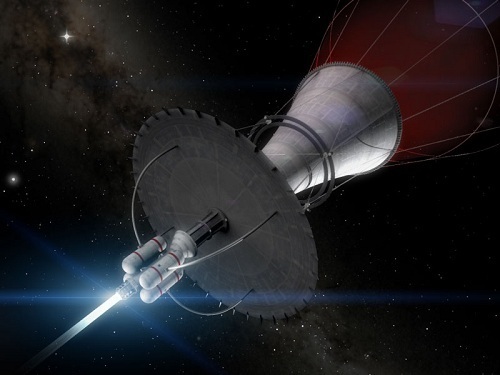
Image: An interstellar ramjet at work. Credit: Adrian Mann.
You can imagine a future civilization taking advantage of these principles after establishing a presence around another star. A beaming system in the Solar System could eventually be complemented by one around the other star, so that no matter which way the ship was traveling, it would always be moving into the beam on a round-trip flight. I’ve sought in vain for an illustration of this concept in science fiction (and I keep wondering if Larry Niven hasn’t picked up on it somewhere), but I can find no example. It seems prime material for science fictional use.
Jackson and Whitmire looked at still another wrinkle on this notion in a paper the following year, about which more tomorrow. Today’s paper is “Laser Powered Interstellar Ramjet,” Journal of the British Interplanetary Society Vol. 30 (1977), pp. 223-226.






July 23, 2012
A Closer Look at Medusa
I see that ‘Zarmina’ is back in the news. The informal designation refers to Gliese 581 g, an exoplanet candidate announced by the Lick-Carnegie team in an effort led by Steven Vogt (UC-Santa Cruz). First you see it, then you don’t — Gl 581 g has been controversial from the start, and is now the subject of a new analysis describing a 32-day orbit, a super-Earth in the habitable zone. More on the analysis later in the week, because my purpose today is to keep digging into the options for getting to a place like this once we’re sure it really does exist.
Gl 581 is just over 20 light years from the Sun in the constellation Libra, a red dwarf whose planetary system is one of the nearest yet detected. Among the options for propulsion in a future interstellar probe is Medusa, the brain-child of Los Alamos physicist (now retired) Johndale Solem. As examined here on Friday, Medusa is a nuclear-pulse system, like Orion in that it relies on the explosion of a series of atomic bombs to propel the vehicle. Where Medusa changes the equation is in its use of a gigantic sail, or ‘spinnaker,’ which replaces Orion’s massive pusher plate. The gossamer sail is connected to the payload by high-tensile strength cables.

Image: The Medusa hybrid design, combining nuclear pulse propulsion with a sail. (A) the payload capsule, (B) the winch mechanism, (C) the main tether cable, (D) riser tethers, and (E) the parachute mechanism. Credit: George William Herbert/Wikimedia Commons.
Because I’m just finishing up Kelvin Long’s Deep Space Propulsion (subtitled ‘A Roadmap to Interstellar Flight’), I was curious to see what Long had to say about Medusa, a concept that has received less attention than other nuclear methods like Orion or Daedalus’ inertial confinement fusion (ICF) design. Long wonders whether Medusa might be useful as a deceleration mechanism for a star probe:
As a probe approaches a target destination, the sail is unfurled rearwards with detonations causing a force in the negative thrust direction to the direction of motion. This may only require a small quantity of units to produce this result. Alternatively, ICF capsules could be ignited by laser beams rearwards of the vehicle, giving rise to the same effect, but on a more moderate level.
The immediate objection to this is the complexity of the Medusa mechanism, but Long anticipates this:
One of the biggest problems for the Medusa sail being used in a deceleration mode however is the reliability of it deploying in deep space after decades of being stored away. If the sail doesn’t deploy, then the probe will essentially be a flyby probe with limited observing time of the target star system and potentially left with a lot of unused units, which would have to be destroyed safely in a controlled way by the vehicle main computing system.
Make no mistake about it, Medusa is a complex system (see Friday’s post for a diagram of the propulsion cycle). Solem’s initial Los Alamos report refers to a canopy with a radius of 500 meters. The plan is to spin-deploy it and its 104 tethers, each made of high-strength polyethylene (aligned polyethylene) material, though Solem notes that superior materials will be available by the time the kind of manned missions he envisions come into play. Remember that he was thinking in terms of an interplanetary mission with Mars as the primary destination. Solem’s sketch, at the end of the Los Alamos report, gives you a feel for the idea, but translate this webwork of lines into fully 10000 tethers and ponder the issues such a contraption raises.
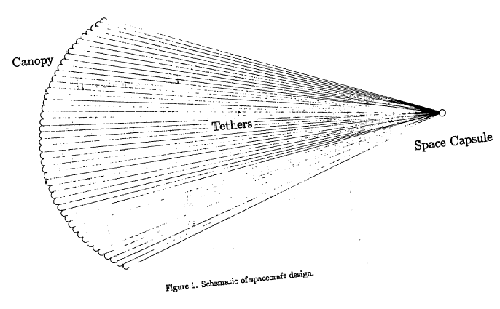
Image: Medusa and its tethers, as sketched by Johndale Solem. Credit: Los Alamos National Laboratory.
The problem of deployment and storage is enormous, and I can see why Long would wonder about re-deploying such a system after a lengthy interstellar transit, which is why he also considers it in terms of a first-stage booster, to be ejected after use. On the other hand, Solem’s calculations in the Los Alamos report and elsewhere showed that the canopy should be able to withstand the ignition of nuclear devices that would propel it. The tethers are another matter — as noted by ‘Eniac’ in the comments to Friday’s post, the tethers have to absorb the blast energy and are obviously crucial to the design. Like Robert Forward, Solem liked to think big, and in this case a gigantic canopy with extremely long tethers was expected to minimize radiation dangers for the crew and allow the tethers to survive the acceleration phase of the mission.
How fast could Medusa fly? The answer depends on the number of propulsion units detonated, with each detonation pulse adding to the velocity. Long also points out that the larger the canopy area, and the closer the canopy is to the detonation point, the higher the velocity. Using the values given in Solem’s 1993 paper in the Journal of the British Interplanetary Society, Long comes up with a specific impulse of 4100 kilometers per second, with an exhaust velocity in the region of 40 km/s.
Like Orion, Medusa runs into the problem of putting nuclear materials into space, one that Solem was all too familiar with. In the conclusion of the Los Alamos report, he has this to say:
We are currently prohibited by treaty from: (1) deploying weapons of mass destruction in space and (2) testing nuclear weapons in space. MEDUSA violates neither the letter nor the spirit of either prohibition, but it does use nuclear explosives. The radioactive debris from MEDUSA’s exhaust is so finely dispersed that it will be nearly undetectable. I assert that MEDUSA’S net environmental impact is less than NERVA; you have to do something with the spent reactor. I see no reason why nuclear explosive propulsion for interplanetary missions cannot be made politically acceptable. Perhaps we can be more creative and consider an international mission in which the nuclear explosives were jointly supplied by the superpowers. What a wonderful approach to nuclear disarmament and the enhancement of science for the benefit of all humanity!
Orion proponents make the same case, that their design would allow us to use up our nuclear stockpile for peaceful purposes while offering large vehicles for deep space exploration. It’s a utopian vision, and in both cases, it’s hard to see it happening anytime soon. Nuclear-pulse propulsion may make sense in space, but you first have to get the nuclear materials off the planet. The nuclear issue is one reason Friedwardt Winterberg, back in 1971, developed the idea of using intense, relativistic electron beams to ignite fusion, a method that captured the attention of the team developing Project Daedalus for the British Interplanetary Society. In such ways do the problems of one propulsion concept play into the revised thinking that fuels the next.
Citations for Solem’s Los Alamos report and his 1993 JBIS paper are at the end of last Friday’s post. I also want to mention two other papers by Solem: “The Moon and the Medusa: Use of Lunar Assets in Nuclear-Pulse Propelled Space Travel,” JBIS Vol. 53 (2000), pp. 362-370 and “Deflection and Disruption of Asteroids on Collision Course with Earth,” JBIS Vol. 53 (2000), pp. 180-196.






Paul Gilster's Blog
- Paul Gilster's profile
- 7 followers



